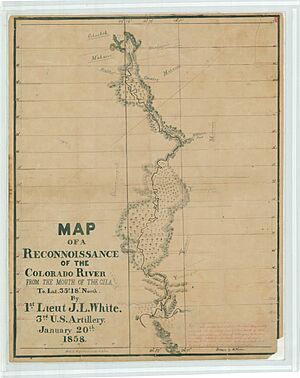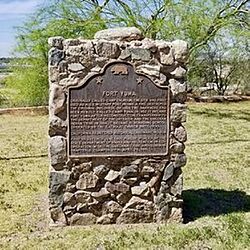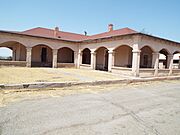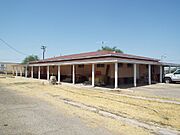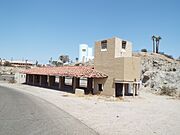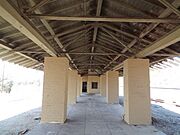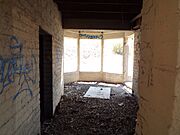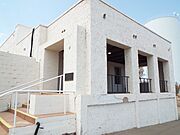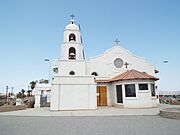Fort Yuma facts for kids
Quick facts for kids Fort Yuma |
|
|---|---|
| Part of Department of the West | |
| Imperial County, California, USA | |

Fort Yuma in 1875
|
|
| Coordinates | 32°43′55″N 114°36′58″W / 32.732°N 114.616°W |
| Type | Outpost |
| Site information | |
| Owner | Federal government of the United States |
| Controlled by | Bureau of Indian Affairs |
| Open to the public |
Yes |
| Condition | Restored |
| Site history | |
| Built | 1851 |
| Built by | United States Army |
| In use | 1851–83 |
| Materials | Adobe, Wood |
| Battles/wars | Yuma War Mohave War American Civil War |
| Garrison information | |
| Past commanders |
Samuel P. Heintzelman George Henry Thomas |
| Garrison | 1st Dragoons 2nd Infantry Regiment 6th Infantry Regiment Quartermaster Corps 1st California Infantry |
| Occupants | United States Army Quechan Tribe of the Fort Yuma Indian Reservation |
| Part of: | Yuma Crossing and Associated Sites |
| Reference #: | 66000197 |
| Designated: | November 13, 1966 |
| Part of: | Yuma Crossing and Associated Sites |
| Reference #: | 806 |
Fort Yuma was an important fort in California. It was located in Imperial County, right across the Colorado River from Yuma, Arizona. The fort was first set up in 1848.
It became a busy stop on the Butterfield Overland Mail route from 1858 to 1861. This was a famous stagecoach line that carried mail and passengers. Fort Yuma stopped being an active military base on May 16, 1883. It was then given to the Department of the Interior, a government department.
Today, the Fort Yuma Indian School and the Saint Thomas Yuma Indian Mission are on the same spot. Fort Yuma is also part of the Yuma Crossing and Associated Sites. This area is listed on the National Register of Historic Places and is a California Historical Landmark (number 806).
Contents
History of Fort Yuma
Early Days of the Fort
Fort Yuma was first built after the Mexican–American War ended in 1848. It was originally very close to the Colorado River. The fort's main job was to protect the new town of Yuma, which was then in New Mexico Territory. It also helped guard the nearby border with Mexico.
In March 1851, the fort was moved to a higher spot on the west bank of the Colorado River. This new location was once called Camp Calhoun. It was set up in 1849 by Lieutenant Cave J. Couts. Soldiers at the fort also ran a ferry service. This ferry helped people traveling through the area.
Fort Yuma was built during the Yuma War. Its purpose was to protect a travel route to California. It also aimed to control the Quechan people, also known as Yumans, in their homeland. Captain Samuel P. Heintzelman established the fort. He first named it 'Camp Independence.'
In March 1851, when the fort moved, its name changed to Camp Yuma. A year later, it became known as Fort Yuma. In June 1851, the Army almost left the fort because it was too expensive to keep. It was completely empty by December 6, 1851, as it had no supplies left. However, Captain Heintzelman came back and reopened the fort on February 29, 1852.
It was very hard to get supplies to the fort in its early years. Food and building materials came by ship from San Diego, California. They sailed all the way around the Baja Peninsula and up the Gulf of California. Then, at the mouth of the Colorado River in Mexico, everything had to be moved to wagons. Hauling these goods across the desert to Yuma was very difficult and took a long time.
Life at the fort was tough. The military often wondered if they should keep the fort open. But after August 1852, Camp Yuma became the permanent Fort Yuma. The Army decided to stay for good. In November 1852, a steamboat called Uncle Sam was launched. It started carrying goods up the Colorado River in December. This steamboat delivered 32 tons of supplies to Fort Yuma. Steamboats continued to supply the fort and other towns until the railroad arrived in 1877.
Only one military event happened right at the fort. During the Yuma War, Yuman warriors surrounded the fort. They temporarily trapped future general Thomas William Sweeny and a few others. This action was led by Matthew P. Coltrain. He received a Medal of Honor for his brave actions.
From 1858 to 1861, the Butterfield Overland Mail had a stagecoach station near the fort. Other stagecoach lines used this station until the railroad arrived in 1877.
Fort Yuma During the Civil War
During the American Civil War, the Union Army kept control of Fort Yuma. Soldiers from the 1st California Infantry took over from the regular Army troops in December 1861. These regular troops were sent to fight in the East.
The southern part of New Mexico Territory tried to leave the Union. It became the Confederate Territory of Arizona. But in 1862, the California Column marched from Fort Yuma. They pushed the Confederate forces out, even marching as far as western Texas. By 1863, the Union controlled the area, calling it the Arizona Territory. Fort Yuma became the main place for supplying Union soldiers there. There were no battles at the fort itself because the western United States was far from the main Civil War fighting.
After the Civil War
Fort Yuma worked closely with the Yuma Quartermaster Depot. This depot was on the Arizona side of the river. It sent military supplies and soldiers to bases all over Arizona and New Mexico. The Quartermaster Depot operated from 1864 to 1891. However, the Army stopped most of its work there eight years earlier.
The Army used the depot to store and send out supplies. These supplies went to all military posts in Arizona, Nevada, Utah, New Mexico, and Texas. This was during the time of the American Indian Wars. The depot always kept a six-month supply of clothes, food, ammunition, and other goods. Supplies came from California by ocean ships. These ships sailed around the Baja Peninsula to Port Isabel, near the mouth of the Colorado River. From there, the goods were moved to river steamers. These steamers carried them upstream to Yuma.
Supplies were unloaded at the depot. Then, they were hauled up a track from the dock to a storehouse. The depot had stables for up to 900 mules. It also had teams of workers to handle them. The Southern Pacific Railroad reached Yuma in 1877. After the railroad arrived, there was less need for the Quartermaster Depot and Fort Yuma. Both were closed on May 16, 1883. The land was given to the Interior Department on July 22, 1884.
Fort Yuma Today
Today, Fort Yuma is part of the Fort Yuma Indian Reservation. Many old buildings from the military days are still standing. These are part of the Yuma Crossing and Associated Sites in the Yuma Crossing National Heritage Area. The Yuma Territorial Prison and Yuma Quartermaster Depot State Historic Park are in Arizona. Their buildings have been saved or rebuilt, and they have museums. The Yuma Proving Ground is the modern Army base that continues the military history of the Yuma area.
Historic Structures at Fort Yuma
The following pictures show some of the old buildings at Fort Yuma.
See also
 In Spanish: Fuerte Yuma para niños
In Spanish: Fuerte Yuma para niños


